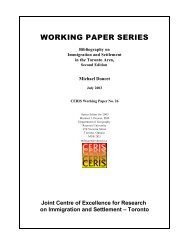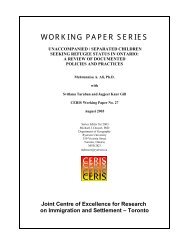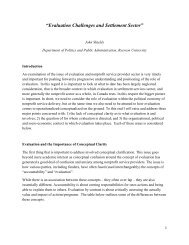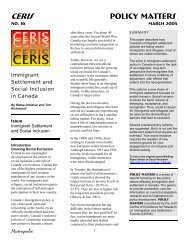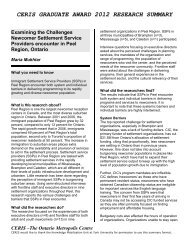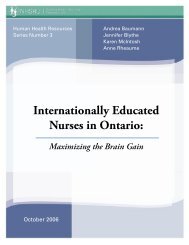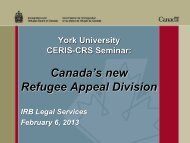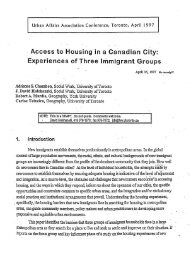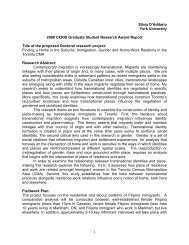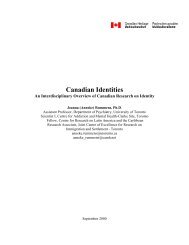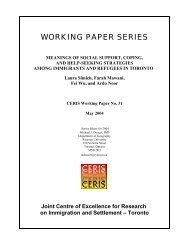Chapter 2EducationIf educational credentials are no longer sufficient to assure steady, pleasant and remunerativeemployment, education rema<strong>in</strong>s a critical aspect <strong>of</strong> human capital. While <strong>in</strong>dividuals with little formaleducation may be highly literate, on average people with more formal education obta<strong>in</strong> better jobs, earnmore and have higher family <strong>in</strong>comes. Rapid technological change, moreover, is likely to <strong>in</strong>crease <strong>the</strong><strong>in</strong>come differential between jobs requir<strong>in</strong>g high and low levels <strong>of</strong> education. There is also a critical <strong>in</strong>tergenerationalaspect to education, <strong>in</strong> that parents with less formal education are disadvantaged <strong>in</strong> deal<strong>in</strong>gwith <strong>the</strong>ir children’s schools and provid<strong>in</strong>g advice to <strong>the</strong>ir children.In this Chapter, <strong>the</strong> ma<strong>in</strong> focus is on <strong>the</strong> overall distribution <strong>of</strong> education for people between 25 and64 years <strong>of</strong> age, given <strong>in</strong> Table 4. The age limits are designed to exclude most people who are still <strong>in</strong>school and also people who are likely to have retired. Table 5 provides <strong>in</strong>formation on <strong>the</strong> educationalatta<strong>in</strong>ment and enrollment <strong>of</strong> young people, between 20 and 24 years <strong>of</strong> age. This is <strong>the</strong> critical ageperiod when most <strong>of</strong> <strong>the</strong> <strong>in</strong>dividuals who will ever do so, complete <strong>the</strong>ir post-secondary education, ei<strong>the</strong>rat a community college or university. Those who have left full-time education without a post-secondaryqualification, especially if <strong>the</strong>y have not completed high school, have significantly lower occupationaland f<strong>in</strong>ancial prospects.To help identify <strong>the</strong> ethno-racial groups who are most educationally disadvantaged, Charts 1 and 2show <strong>the</strong> ethno-racial groups with <strong>the</strong> highest percentages <strong>of</strong> adults who have not completed high schooland with <strong>the</strong> lowest percentages <strong>of</strong> university graduates. Similarly, Chart 3 shows <strong>the</strong> groups with <strong>the</strong>highest percentages <strong>of</strong> young people who have not graduated from high school and are no longer <strong>in</strong>school. The groups with <strong>the</strong> lowest levels <strong>of</strong> education, shown <strong>in</strong> <strong>the</strong> charts, are also listed <strong>in</strong> <strong>the</strong>summary table <strong>in</strong> Chapter 5, which collates <strong>the</strong> f<strong>in</strong>d<strong>in</strong>gs <strong>of</strong> <strong>the</strong> three chapters deal<strong>in</strong>g with education,occupations and <strong>in</strong>come.<strong>Ethno</strong>-<strong>Racial</strong> <strong>Inequality</strong> <strong>in</strong> <strong>Toronto</strong>: <strong>An</strong>alysis <strong>of</strong> <strong>the</strong> 1996 Census 35
Table 4Highest Level <strong>of</strong> Education, for Persons 25-64 Years <strong>of</strong> Age, by <strong>Ethno</strong>-<strong>Racial</strong> GroupHighest Level <strong>of</strong> Education(percentage distribution)Some High Trade M.A. Number <strong>of</strong>No High High School School College Some University Degree Persons<strong>Ethno</strong>-<strong>Racial</strong> Group School School Graduate Graduate Graduate University Graduate & Higher Total 25-64Total 14.1 16.4 22.0 7.9 14.0 2.9 17.2 5.5 100.0 1,642,135Total: Aborig<strong>in</strong>al 7.3 20.3 25.5 10.0 17.2 2.0 13.4 4.2 100.0 12,940Aborig<strong>in</strong>al 14.8 27.8 25.5 11.3 13.5 1.1 5.1 0.9 100.0 2,665Aborig<strong>in</strong>al and British/French 7.0 19.8 26.0 9.5 16.5 1.9 14.1 5.0 100.0 4,660Aborig<strong>in</strong>al and non-British/French 3.9 17.2 25.1 9.9 19.4 2.5 16.9 5.0 100.0 5,615Total: African, Black and Caribbean 8.5 18.2 26.6 12.5 21.1 2.4 8.6 2.1 100.0 125,450Ethiopian 7.0 16.8 35.5 8.3 16.0 3.3 9.6 3.5 100.0 4,590Ghanaian 16.8 14.9 38.1 4.4 10.0 3.4 9.6 2.7 100.0 6,380Somali 4.7 18.1 31.5 16.1 18.5 2.8 5.4 3.0 100.0 3,955O<strong>the</strong>r African Nations 5.2 13.1 25.7 11.6 18.6 4.7 16.1 5.1 100.0 10,190African and South/East Asian 9.8 8.7 18.5 11.3 29.5 3.6 16.0 2.2 100.0 1,375African and European/Arab/West Asian 3.3 11.3 23.9 11.1 18.6 3.3 20.8 7.5 100.0 2,260African and Black 9.6 22.9 25.8 12.0 19.2 2.2 6.2 2.2 100.0 6,965Barbadian 3.9 19.8 20.8 13.6 28.1 2.5 9.0 2.0 100.0 2,985Guyanese 12.1 24.3 25.7 11.1 17.6 1.9 6.1 1.2 100.0 8,585Jamaican 10.4 23.1 25.1 13.9 20.6 1.2 4.8 0.9 100.0 40,075Tr<strong>in</strong>idadian and Tobagonian 6.3 13.1 26.2 15.8 23.9 2.5 10.1 2.2 100.0 6,470West Indian 7.9 18.0 29.2 14.5 22.3 1.8 5.4 0.9 100.0 9,800O<strong>the</strong>r Caribbean nations 6.5 16.1 27.0 14.1 24.3 1.7 8.4 1.9 100.0 5,495Multiple Caribbean 4.0 12.2 26.9 9.6 31.7 2.0 11.9 1.7 100.0 1,765Caribbean and South Asian 10.2 15.5 22.4 12.3 22.5 4.8 10.3 2.1 100.0 5,365Caribbean and East Asian 2.0 9.6 25.1 9.3 29.4 2.6 19.0 2.9 100.0 1,715Caribbean & European/Arab/Lat<strong>in</strong> American 4.1 11.5 23.8 11.8 27.3 4.0 14.6 3.0 100.0 7,480Total: South Asian 11.5 20.7 24.0 7.2 12.3 3.4 15.5 5.4 100.0 119,720Indian 13.2 18.3 22.1 7.7 12.6 3.3 16.7 6.1 100.0 79,075Pakistani and Bangladeshi 9.7 13.4 24.8 6.2 9.1 5.6 22.4 9.0 100.0 5,575Sri Lankan 8.2 33.6 30.9 5.8 10.5 2.8 7.1 1.0 100.0 12,320Tamil 7.1 34.3 31.5 5.2 9.8 2.0 8.5 1.6 100.0 8,160Multiple South Asian 9.4 23.8 24.7 6.2 11.4 3.6 15.5 5.5 100.0 9,110South Asian and East Asian 6.5 11.2 27.1 9.4 22.9 5.3 11.8 5.9 100.0 850South Asian and European/Arab/West Asia 5.8 9.3 21.6 9.4 20.0 5.2 21.4 7.3 100.0 4,630Source: Statistics Canada 1996 Census; Tabulation by Michael Ornste<strong>in</strong>, Institute for Social Research, York University<strong>Ethno</strong>-<strong>Racial</strong> <strong>Inequality</strong> <strong>in</strong> <strong>Toronto</strong>: <strong>An</strong>alysis <strong>of</strong> <strong>the</strong> 1996 Census 36
- Page 6 and 7: origin, South Asians, Arab and West
- Page 8 and 9: Table of ContentsExecutive Summary.
- Page 10 and 11: IntroductionThis Report provides de
- Page 12 and 13: Methodological NotesThis Report pro
- Page 14 and 15: Chapter 1Defining Ethno-Racial Grou
- Page 16 and 17: question, described above. The “C
- Page 18 and 19: “Barbadians.” Likewise, people
- Page 20 and 21: acial identification question, redu
- Page 22 and 23: Table 1, continuedEthno-Racial Grou
- Page 24 and 25: percentage of a group has the need.
- Page 26 and 27: ARAB AND WEST ASIAN ORIGINSApproxim
- Page 28 and 29: EUROPEAN ORIGIN GROUPS TEND TO BE O
- Page 30 and 31: The key question involves the numbe
- Page 32 and 33: Table 2, continuedPercentage and Nu
- Page 34 and 35: A second policy concern involves th
- Page 36 and 37: NON-NATIONAL, “RACIAL” AND MULT
- Page 38 and 39: Table 3, continuedKnowledge of Engl
- Page 40 and 41: majority of people speak English. T
- Page 42 and 43: Fully 96.1 percent of Torontonians
- Page 46 and 47: Table 4, continuedHighest Level of
- Page 48 and 49: Ethno-Racial Inequality in Toronto:
- Page 50 and 51: Educational Attainment of AdultsAbo
- Page 52 and 53: EUROPEAN ORIGINAmong Europeans, edu
- Page 54 and 55: GROUPS WITH HIGHER PROPORTIONS OF N
- Page 56 and 57: Table 5, continuedSchool Attendance
- Page 58 and 59: Ethno-Racial Inequality in Toronto:
- Page 60 and 61: Of most concern are the small numbe
- Page 62 and 63: Not counted as unemployed are “di
- Page 64 and 65: Table 6, continuedLabour Force Char
- Page 66 and 67: Ethno-Racial Inequality in Toronto:
- Page 68 and 69: percent for the African, Black and
- Page 70 and 71: LATIN AMERICAN ORIGINSThe two Latin
- Page 72 and 73: Table 7, continuedIncome from Emplo
- Page 74 and 75: efore coming to Canada likely refle
- Page 76 and 77: Table 8a, continuedOccupations of W
- Page 78 and 79: Table 8bOccupations of Men by Ethno
- Page 80 and 81: Table 8b, continuedOccupations of M
- Page 82 and 83: Ethno-Racial Inequality in Toronto:
- Page 84 and 85: eing an employee; just 3.2 percent
- Page 86 and 87: Table 9, continuedIncidence of Self
- Page 88 and 89: AFRICAN, BLACK AND CARIBBEAN ORIGIN
- Page 90 and 91: esult in similar levels of income.
- Page 92 and 93: Among the individual ethno-racial g
- Page 94 and 95:
Chapter 4Poverty and Individual and
- Page 96 and 97:
Introduction to the TablesThe first
- Page 98 and 99:
Table 10, continuedIncidence of Pov
- Page 100 and 101:
Ethno-Racial Inequality in Toronto:
- Page 102 and 103:
Table 11, continuedIncidence of Chi
- Page 104 and 105:
Ethno-Racial Inequality in Toronto:
- Page 106 and 107:
types of families are not an intuit
- Page 108 and 109:
children and 12.8 percent of Arab/W
- Page 110 and 111:
Table 12, continuedIncidence of Pov
- Page 112 and 113:
Southeast Asians and Pacific Island
- Page 114 and 115:
Table 13, continuedMedian Family In
- Page 116 and 117:
Ethno-Racial Inequality in Toronto:
- Page 118 and 119:
Table 14, continuedMedian Individua
- Page 120 and 121:
Ethno-Racial Inequality in Toronto:
- Page 122 and 123:
SOUTH ASIAN ORIGINSWhile just over
- Page 124 and 125:
LATIN AMERICAN ORIGINSDue to statis
- Page 126 and 127:
There are remarkable ethno-racial d
- Page 128 and 129:
Table 15, continuedHome Ownership o
- Page 130 and 131:
percent of Italian families own the
- Page 132 and 133:
The most severe disadvantage affect
- Page 134 and 135:
Men in Lower SkillJobs(Table 8b/Cha
- Page 136 and 137:
which included all other African na
- Page 138 and 139:
In Lower Skill Non-Manual Occupatio
- Page 140 and 141:
skilled non-manual occupations in 1
- Page 142:
segregation, the effects of unequal



